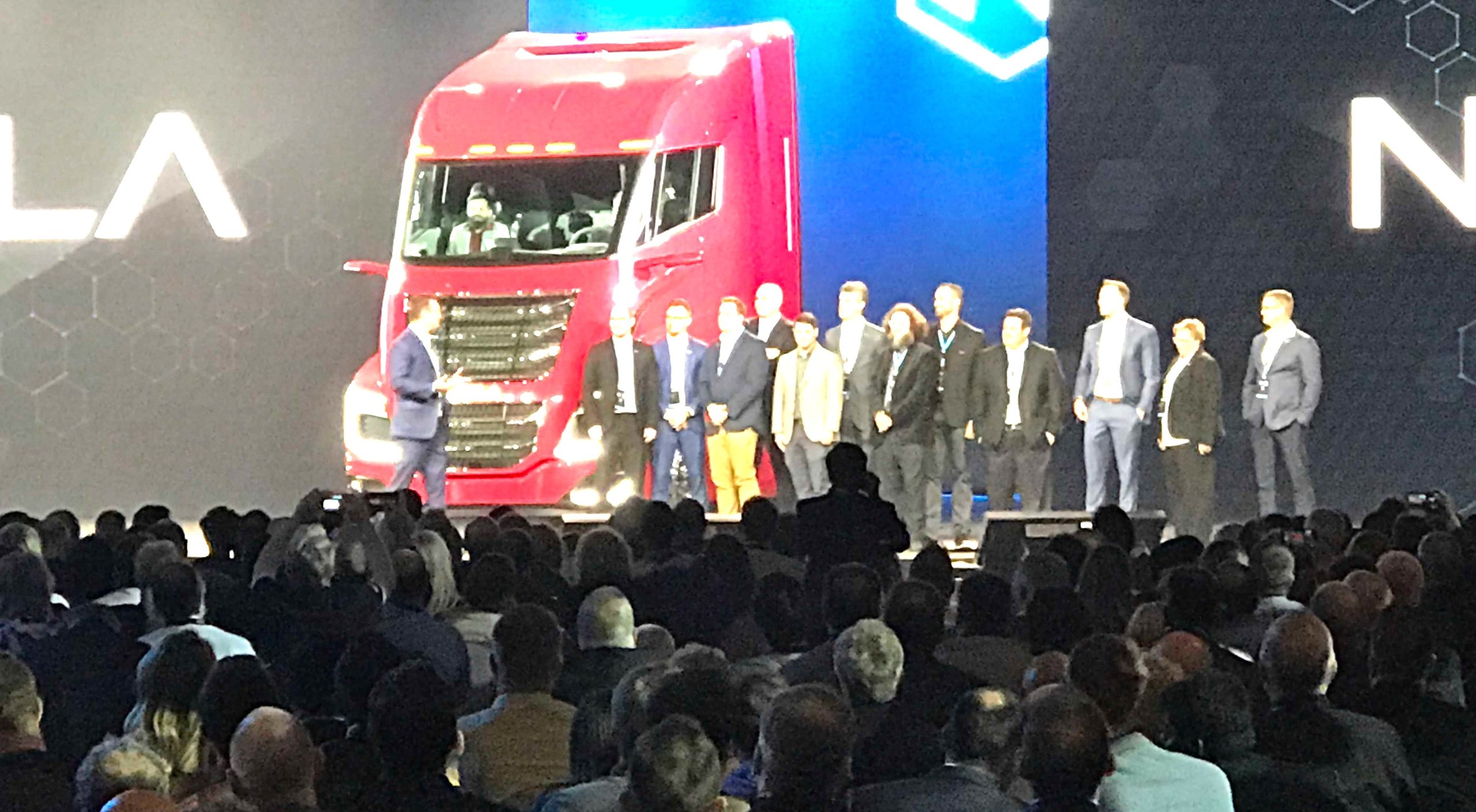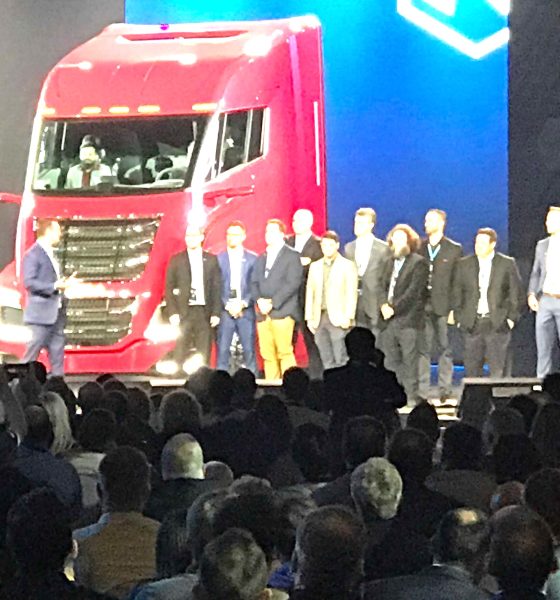

News
Nikola takes ‘silencing your critics’ a bit too literally with copyright strikes on YouTube
Hydrogen trucking startup Nikola has taken an assertive stance against its critics, with the company forcing the removal of several videos on YouTube over alleged copyright infringement issues. The videos in question allegedly included proprietary content, including sections of the startup’s “Nikola One in Motion” advertisement, which featured a prototype truck from the company being rolled down a hill.
As noted in a Financial Times report, a number of financial commentator channels on YouTube have reported that they received takedown notices from the hydrogen truck maker, resulting in several videos being removed from the video-sharing platform. In a statement to the publication, Sam Alexander, a Nikola critic and YouTube host, stated that he received notifications on Wednesday that at least four of his videos were reported for copyright infringement. All four of the videos featured sections of the “Nikola One in Motion” ad.
The same was true for fellow content creator Tom Nash, whose finance-themed channel has 41,000 subscribers. According to Nash, he was required to take down three critical Nikola videos including one that featured sections of the rolling Nikola One prototype. Nikola reportedly took issue with Nash’s use of videos that featured its prototype jet ski and hydrogen station as well. “It’s what you would call a death sentence for a creator. This is my livelihood. I have three kids. I quit my job to do this,” Nash told the FT.
Amidst concerns that the company seems to be looking to silence its critics, a spokesperson from Nikola explained that YouTube identifies copyright violations and shares this data with the company. The spokesperson added that based on the information shared by YouTube, Nikola was able to submit takedown notices against videos that included content that was used without permission.
“YouTube regularly identifies copyright violations of Nikola content and shares the lists of videos with us. Based on YouTube’s information, our initial action was to submit takedown requests to remove the content that was used without our permission. Going forward, we will evaluate these flagged videos on a case-by-case basis,” the spokesman said.
This explanation, however, was disputed to a degree by a spokesman from YouTube. Alex Joseph, a YouTube spokesman, notified the Financial Times that the platform’s copyright match tool does not automatically remove any videos. Joseph added that content creators who believe that their videos were wrongfully flagged could dispute the takedown notices.
“Nikola has access to our copyright match tool, which does not automatically remove any videos. Users must fill out a copyright removal request form, and when doing so we remind them to consider exceptions to copyright law. Anyone who believes their reuse of a video or segment is protected by fair use can file a counter-notice,” the YouTube spokesperson remarked.
Nikola has recently been met with a lot of turbulence. Following a damning report from short-seller firm Hindenburg Research, which accused the company of misleading investors, the company was rocked by the departure of founder Trevor Milton. Milton, for his part, has also met controversy over allegations of inappropriate behavior against women in the past. Amidst these reports, Nikola has announced that it will be postponing Nikola World 2020, the event that was expected to unveil the Badger, the company’s answer to the Tesla Cybertruck and the Rivian R1T.

Elon Musk
Elon Musk and Tesla AI Director share insights after empty driver seat Robotaxi rides
The executives’ unoccupied tests hint at the rapid progress of Tesla’s unsupervised Robotaxi efforts.

Tesla CEO Elon Musk and AI Director Ashok Elluswamy celebrated Christmas Eve by sharing personal experiences with Robotaxi vehicles that had no safety monitor or occupant in the driver’s seat. Musk described the system’s “perfect driving” around Austin, while Elluswamy posted video from the back seat, calling it “an amazing experience.”
The executives’ unoccupied tests hint at the rapid progress of Tesla’s unsupervised Robotaxi efforts.
Elon and Ashok’s firsthand Robotaxi insights
Prior to Musk and the Tesla AI Director’s posts, sightings of unmanned Teslas navigating public roads were widely shared on social media. One such vehicle was spotted in Austin, Texas, which Elon Musk acknowleged by stating that “Testing is underway with no occupants in the car.”
Based on his Christmas Eve post, Musk seemed to have tested an unmanned Tesla himself. “A Tesla with no safety monitor in the car and me sitting in the passenger seat took me all around Austin on Sunday with perfect driving,” Musk wrote in his post.
Elluswamy responded with a 2-minute video showing himself in the rear of an unmanned Tesla. The video featured the vehicle’s empty front seats, as well as its smooth handling through real-world traffic. He captioned his video with the words, “It’s an amazing experience!”
Towards Unsupervised operations
During an xAI Hackathon earlier this month, Elon Musk mentioned that Tesla owed be removing Safety Monitors from its Robotaxis in Austin in just three weeks. “Unsupervised is pretty much solved at this point. So there will be Tesla Robotaxis operating in Austin with no one in them. Not even anyone in the passenger seat in about three weeks,” he said. Musk echoed similar estimates at the 2025 Annual Shareholder Meeting and the Q3 2025 earnings call.
Considering the insights that were posted Musk and Elluswamy, it does appear that Tesla is working hard towards operating its Robotaxis with no safety monitors. This is quite impressive considering that the service was launched just earlier this year.
Elon Musk
Starlink passes 9 million active customers just weeks after hitting 8 million
The milestone highlights the accelerating growth of Starlink, which has now been adding over 20,000 new users per day.

SpaceX’s Starlink satellite internet service has continued its rapid global expansion, surpassing 9 million active customers just weeks after crossing the 8 million mark.
The milestone highlights the accelerating growth of Starlink, which has now been adding over 20,000 new users per day.
9 million customers
In a post on X, SpaceX stated that Starlink now serves over 9 million active users across 155 countries, territories, and markets. The company reached 8 million customers in early November, meaning it added roughly 1 million subscribers in under seven weeks, or about 21,275 new users on average per day.
“Starlink is connecting more than 9M active customers with high-speed internet across 155 countries, territories, and many other markets,” Starlink wrote in a post on its official X account. SpaceX President Gwynne Shotwell also celebrated the milestone on X. “A huge thank you to all of our customers and congrats to the Starlink team for such an incredible product,” she wrote.
That growth rate reflects both rising demand for broadband in underserved regions and Starlink’s expanding satellite constellation, which now includes more than 9,000 low-Earth-orbit satellites designed to deliver high-speed, low-latency internet worldwide.
Starlink’s momentum
Starlink’s momentum has been building up. SpaceX reported 4.6 million Starlink customers in December 2024, followed by 7 million by August 2025, and 8 million customers in November. Independent data also suggests Starlink usage is rising sharply, with Cloudflare reporting that global web traffic from Starlink users more than doubled in 2025, as noted in an Insider report.
Starlink’s momentum is increasingly tied to SpaceX’s broader financial outlook. Elon Musk has said the satellite network is “by far” the company’s largest revenue driver, and reports suggest SpaceX may be positioning itself for an initial public offering as soon as next year, with valuations estimated as high as $1.5 trillion. Musk has also suggested in the past that Starlink could have its own IPO in the future.
News
NVIDIA Director of Robotics: Tesla FSD v14 is the first AI to pass the “Physical Turing Test”
After testing FSD v14, Fan stated that his experience with FSD felt magical at first, but it soon started to feel like a routine.

NVIDIA Director of Robotics Jim Fan has praised Tesla’s Full Self-Driving (Supervised) v14 as the first AI to pass what he described as a “Physical Turing Test.”
After testing FSD v14, Fan stated that his experience with FSD felt magical at first, but it soon started to feel like a routine. And just like smartphones today, removing it now would “actively hurt.”
Jim Fan’s hands-on FSD v14 impressions
Fan, a leading researcher in embodied AI who is currently solving Physical AI at NVIDIA and spearheading the company’s Project GR00T initiative, noted that he actually was late to the Tesla game. He was, however, one of the first to try out FSD v14.
“I was very late to own a Tesla but among the earliest to try out FSD v14. It’s perhaps the first time I experience an AI that passes the Physical Turing Test: after a long day at work, you press a button, lay back, and couldn’t tell if a neural net or a human drove you home,” Fan wrote in a post on X.
Fan added: “Despite knowing exactly how robot learning works, I still find it magical watching the steering wheel turn by itself. First it feels surreal, next it becomes routine. Then, like the smartphone, taking it away actively hurts. This is how humanity gets rewired and glued to god-like technologies.”
The Physical Turing Test
The original Turing Test was conceived by Alan Turing in 1950, and it was aimed at determining if a machine could exhibit behavior that is equivalent to or indistinguishable from a human. By focusing on text-based conversations, the original Turing Test set a high bar for natural language processing and machine learning.
This test has been passed by today’s large language models. However, the capability to converse in a humanlike manner is a completely different challenge from performing real-world problem-solving or physical interactions. Thus, Fan introduced the Physical Turing Test, which challenges AI systems to demonstrate intelligence through physical actions.
Based on Fan’s comments, Tesla has demonstrated these intelligent physical actions with FSD v14. Elon Musk agreed with the NVIDIA executive, stating in a post on X that with FSD v14, “you can sense the sentience maturing.” Musk also praised Tesla AI, calling it the best “real-world AI” today.








